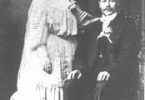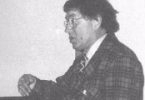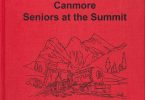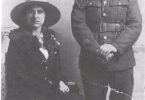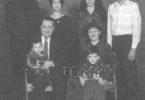I was born in the Mannville Hospital, November 28, 1931, the oldest of seven children, four boys and three girls. My parents were Maxine and Louie Larson. My dad was considered to be the first white baby born in the district. Being fifty five miles from the nearest settlement, they had to deliver their own babies and later that of other settlers as they came in. When my dad was about twelve, he caught his hand in the pump engine, pulling his thumb off. Grandpa probably sterilized the thumb with salt water and creolin. Grandma had been told the year before to use moldy bread for poultices. They packed that thumb with moldy bread, healing the thumb. Was this the forerunner of penicillin? Pine tar in a mask was worn to town to prevent the spread of germs. Later during the bad ‘flu epidemic of 1919, people remembered my grandpa and his pine tar mask. Many years later those who belonged in the M.D. of Mannville received free doctor and hospitalization in Mannville. Presumably other municipal districts had the same scheme.
I was raised on a farm north of Irma and south of Mannville, twenty-four miles. The school I went to was called Education Point although it was on my dad’s land. I had not seen the school until the first day. My first teacher was Verna Robertson, a person much admired. A favorite teacher was Gerta Rosen (Nordstrom), a pianist, who taught me grade two, giving me a straight pen and ink and allowing me to write. Usually students were not allowed to use these pens until the end of grade three. This was especially important to me, considering that I even had a fountain pen and ink of my own from my grandmother before I started school. Art Larson, grade three teacher, opened the door to acrobatics for me, something that was common in my family. In grades seven and eight we did correspondence in the school. In grade nine I rode six miles to the Albert school. In grades ten to twelve I was boarded out in town with the Rohrers. Their daughter Dicksie is my long time friend. When visiting her farm we always said we could make a meal out of pigweeds, buttermilk and eggs to feed our kids. Farm kids were given excusable absences in the spring and fall to help with farm work. I was the only girl in high school to sign out for harvest leave. Upon returning to school, an occurence happened which could have sent me running for the rangeland never to return; it was so embarrassing. Our P.T. classes were held outside if the weather was fit. The teacher, knowing that I did a lot of acrobatics for entertainment, asked me to lead the classes that day. After the war, when there was a shortage of zippers, slacks were held together by about two inches of zipper. D.H. Gunn, the teacher, asked if I would show the students some aerial flips. A rancher’s son got on all fours so I could do a flip in the air. So while doing my flip, my hand must have caught the zipper and to my dismay everyone saw I wore floral panties.
The prairies were a time of box socials, skating, house parties, music, threshing crews and moving hundreds of cattle to the hills. There were card parties, sports days and stampedes. Old-fashioned Christmas concerts exposed us to our first theatrical productions.
Amongst other things, my dad and relatives built brushcutters and rockpickers. All Larson farms had their own blacksmith shop where they shod horses, shaped horseshoes, sharpened things and made repairs. It was a different era. It was also the era of fresnos to build roads with horses. It was the time of cars up on blocks for the winter. Taffypulls, also making our own ice cream as we milked cows and shipped cream. We did our own branding, dehorning, castrating the animals. Sometimes a cutter with sleigh runners and a propeller at the back (a snowplane) was used in the winter. As these snowplanes were not too successful people depended on horses and cutters, sleighs, etc. Farmers and ranchers could build roads offsetting their taxes. We had our own threshing and haying crews. Bunkhouses were moved to the hills in haying time.
Gypsies used to come camping each summer on my dad’s land. The Jewish gentleman who used to come selling his wares disappeared when the war came, a great loss as I enjoyed the times they were there. Another thing there were the fox farms and the mink farms. One of the neighbors had hounds that caught coyotes. I detested this. A terrible idea was to destroy crow and magpie nests, take the eggs, kill the babies and collect gopher tails. I never could do anymore than the eggs. A couple of times I cut the tail off a dead gopher on the road. I once found two dead magpies on the ground. It still grosses me out.
Tramps used to wander the roads, often working only for food. My relatives’ doors were always open. Dad took in five one time; they lived with us, becoming lifelong friends.
We were raised in an area of cattle rustlers and moonshine stills. I was frequently worried about this because I feared the loss of some special horses and cattle. I rode horses at an early age. Having no fear of these animals, actually becoming somewhat of a show-off as I raced away performing my antics. Most of this was bareback.
Other activities included trackmeet events, playing baseball, softball, skating and tennis. At one point I played fastball for the Mannville Bluebirds, a well-known ball team who frequently won provincials. At sixteen I was sports director for Irma High School.
Music was a big part of our life. Many of my relatives had time to help me learn to play music. I had no formal training but a classical violin player, Ole Nissen, joined our band, basically givng me guidance all the time, resulting in my being able to write music. I started playing for dances at fifteen, playing many stringed instruments plus drums and piano. By the time I was sixteen we had a seven-piece dance band, Larson’s Orchestra. Pay ranged from nothing to sixty percent of the door. Special events brought in more pay. Coming to Canmore, I ended up with another dance band. Tommy Lytkowski played the violin, Johnny Byers played clarinet and B flat horn. Andy Shellian played E flat tenor, accordion and drums. Daryl Lukan was one of our longtime drummers. Carl Dyck, Jal Ableseth and Barry Sproule were also members at various times. We made drummers out of John Randle and Lena Shellian. I was honored to know and to be able to work with Vic Lewis and his school band in the sixties. Three of my children were in it. I often had eight to ten kids practising at my home because their parents could not stand it at their home.
After graduating from grade twelve I stayed in Irma because of the dance band bookings. Ultimately I went to work, first in 1953 at Fuder’s Garage as bookkeeper, then McFarland’s General Store. The drugstore folk’s son was my boyfriend. Because they dealt in jewellery, reading material, cosmetics, etc., Red and I got to join them on buying trips. Along with the retailing, wholesaling, and buying trips with the McFarland’s, this proved to be a valuable education for me later on in the business world. Late delivery of funeral flowers to the drugstore proved to be a weird part of our noon hour. Red and I had to go to the church to arrange the funeral flowers in case the undertaker didn’t return in time from lunch. The first few times of open caskets threw Red. We Larsons, such a big crew, had been to many funerals. Red and I realized though that we did get to say a special goodbye to each one.
I married John Randle who was a surveyor for Farm Electric, responsible for taking power to the farms. Then we moved to Edmonton in 1957. John became a long distance truck driver for Liquid Carbonics. We sold our cattle, invested in trucks, moving with our three children to Calgary in 1959. In 1962 we started trucking to the mountains. Luckily we were able to acquire residence from the Brujhell family, although we had no intention of settling in Canmore, really intending to move to Banff. Thanks to the friendliness of the Marra family, Harris family and many others, Canmore ended up being home, plus a place for our trucks. One of the things was the garbage haul on the town side of the Bow Bridge. Floyd Bray was the government person who gave us the contract. We were paid by the provincial government. (Crossing the Bow Bridge, that was coal mine property. Ed Cadieux hauled their garbage. Garbage was burnt at the Canmore dump out where the industrial development is now on Highway 1A) We sold one trucking line in 1973. 1974 I went to be head guide and wrangler at Rafter Six Guest Ranch. It was the year a group of people were trying to put in a wild game farm. Thank God for Alvin and Eva Guinn who had built the ranch, making it world famous. They were a great help to me at that time.
My family is still involved with trucks and eighteen-wheelers today as well as the arts. We had five children: Diane Lynn, Terri-Lee, Kim Lori, Ward Allan, Tracie Hope, when we moved here; the sixth, Curtis Dean, was born in Banff. John and I are now divorced. Today we have fourteen grandchildren, some inherited.
Fate and destiny must have made it happen that we moved next door to Wyn Palmer, a noted artist who was teaching community art classes for extension classes from the U. of A., thanks to Professor Harry Wohlfarth. Although Wyn Palmer inspired me it appears my hidden artistic talents were trying to get loose at four years old. I painted myself and my younger sister, clothes and all, with red barn paint. It was stored upstairs; it seems to me we stood in it. I loved the brightness and depth of colours even then. As early as 1963 we had an art group here in Canmore. Wyn said, “You get the people. I’ll teach.” Jeanne Marra had the first meeting at her home in 1963. Professor Wohlfarth used to come often, teaching classes here and in Banff. We worked in acrylics, oils, sprays, pens, ink, charcoals, watercolours, silk screens, etc. We owe so much gratitude to Harry Wohlfarth who exposed us to our works chosen to hang in University of Alberta and also travelling expeditions.
Wyn Palmer taught me how to hang our many group art shows we had over the years. I feel very fortunate. I started printing my artwork and that of my children in 1985. A lot of my work and some of my children’s work has gone to galleries and to places such as New York, Chicago, St. Louis, Europe and across Canada and the U.S.
We ran the golf course one season (1964). The first club house had no electricity, outhouses, no water but what we had was pumped and carried in. Moving our piano in for parties, we had a “hoot”. Changes ranged from riding horse to the golf course to take the fees to the changes brought by the security arrangements for the 1988 Olympics. Would you believe security guards with guns?
My brother and I in 1963, exercising horses for an outfitter, rode above the Hoodoos and up where the Benchlands are. It was wilderness and beauty beyond belief: deer, elk, bear, unbelievable. Later on we had our own horses here. We golfed, curled and bowled in Canmore and Banff. While John and I were both ardent addicted golfers one of us always had to be with the business. I always had dance jobs booked (seems my whole life involved there) so many sporting adventures were limited to Calgary, Exshaw, Seebe, Canmore and Banff. John plus buddies like first golf pro here Wayne Stark, Fred Marra, Walter Erickson, Stan Chakowski, Paul Flynn, Don, Pat and Walter Riva, the Towers, Brotch Szuskiel, etc. to name a few went on golfing expeditions across Canada and the United States.
Canmore was a hockey town when we arrived, so we always tried making skating rinks in our backyard. Chinooks raised heck with them. John and I were both involved in many sports. Many times I returned from art class to find new kids at my kitchen table enjoying hot chocolate and food. In 1964 the Marras and Rivas got us into bowling leagues in Banff. John, bringing a late truck in, rushing, brushed his teeth with Brylcreem, much to our laughter. Cardo Marra reminded Jackie Ross and me of that one of the last times I saw him in the hospital. Canmore really is home.
Our family spent a lot of time exploring the mountains. Moving to a coal mining town was a different venture for me. Luckily I was able to drive truck to the mine for deliveries, seeing men lined up waiting for the buses and the coal cars to go underground. Thus I have many hurried artworks from coal mines. When the mine whistle blew for emergency it was scary because we knew it could be an accident. There was no water and sewer in town. “Honey wagons” were used to empty tanks. Water came from wells. Gas was just starting to be installed. After selling the one trucking line, the different areas that I got involved in to support my artsy habits included chambermaiding at the Banff School of Fine Arts. I also worked as matron supervisor for senior citizen lodges in the city of Calgary for five years on call plus working the oil rigs in between time. If you ever see a book called “Call Girl of the Lodges” I will have written it. Thanks to a spunky eighty-seven year old, who tuned me in to the phrase “call girl for these lodges and I knew it was you”. Various other ventures have entailed being a girl Friday for the movie outfits, a Mary Kay consultant, house, business and farm sitting. Along with my spiritual studies have been metaphysical, parapsychology, esoteric, etc. In 1971, I was a confirmed case of Rocky Mountain spotted fever in Canada.
Today I have an apartment at the senior citizen complex and can live my gypsy vagabond lifestyle.
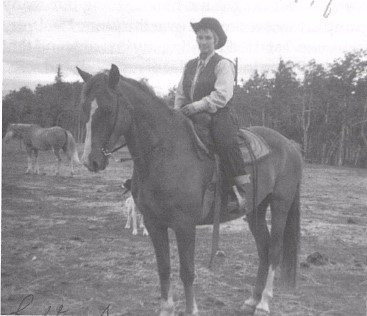
Irene Randle on Big Red, Rafter Six Ranch, 1974
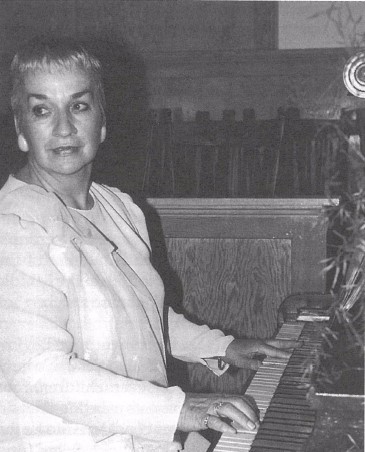
Irene Randle playing for Stacy Michelle’s wedding
In Canmore Seniors at the Summit, ed. Canmore Seniors Association, 2000, p. 237-240.

